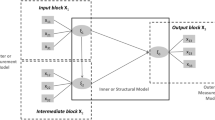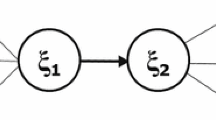Abstract
Composite indicators (CIs), in the social sciences, are used more and more for measuring very complex phenomena as the poverty, the progress and the well-being. Using an approach Model Based in to build CIs, instead of an approach Data Driven, it is possible to consider the role (formative and reflective) of the manifest variables (MVs) and to model the relationships among the CIs. In this article, we begin introducing structural equation modeling (SEM) as a tool for building Model Based CIs. Secondly, among the several methods developed to estimate SEM, we show Partial Least Squares Path Modeling (PLS-PM), due to the key role that estimation of the latent variables (i.e. the CIs) plays in the estimation process. Moreover, we present some recent developments in PLS-PM for the treatment of non metric data, hierarchical data, longitudinal data and multi-block data. Finally, we demonstrate how these recent developments can strongly help in the building of CIs. It is easy to realize, for example, that as a consequence of considering nominal and ordinal data, the knowledge about a phenomenon synthesized by a CI is considerably extended and improved especially for operational use. In order to highlight the potentiality of the proposed approach, the construction of a CI is discussed. In particular, a CI of Social Cohesion, developed by using European Values Study data, will be described in detail.










Similar content being viewed by others
Notes
The word systemic deriving from the definition of the system given by Von Bertalanffy (1983), according to which a system is a set of elements in interaction, not just an aggregation of EIs but a set of indicators linked to each other by mutual relationships, expressed through functional links and summarized in a specific model.
LISREL is the acronym of Linear Structural Relationship a software created by Jöreskog in the seventies to estimate a covariance based SEM model.
In this case the MVs should not covariate, because the latent concept is formed by the MVs.
The convergence of the PLS-PM algorithm is demonstrated by Tenenhaus and Tenenhaus (2009).
The first wave of the survey was launched in 1981 in ten European countries. To explore the dynamics of value changes, a second wave of surveys was launched in 1990 in all European countries, including Switzerland, Austria and countries in Central and Eastern Europe, as well as the US and Canada. About 10 years later (1999/2000), the third EVS survey was launched, the fieldwork being conducted in almost all European countries. The fourth wave was launched in 2008 (http://www.europeanvaluesstudy.eu).
References
Amato, S., Esposito Vinz, V., & Tenenhaus, M. (2004). A global goodness-of-fit index for PLS structural equation modeling. Paris: Oral Communication to PLS Club, HEC School of Management.
Becker, J. M., Rai, A., Ringle, C. M., & Volckner, F. (2013). Discovering unobserved heterogeneity in structural equation models to avert validity threats. MIS Quarterly, 37, 665–694.
Benzecrí, J. P. (1980). Pratique de L’Analyse des Données, Analyse Des Correspondances. Exposé Élementaire. Dunod, Bordas, Paris
Bernard, P. (1999). La cohésion sociale: critique d’un quasi-concept. Lien social et Politiques RIAC, 41, 47–59.
Cailliez, F., & Pagés, J. P. (1976). Introduction á l’Analyse des données. Paris: SMASH.
Carroll, J. D. (1968). Generalization of canonical analysis to three or more sets of variables. In Proceedings of the American psychological association (pp. 227–228).
Chin, W. W. (1998). The partial least squares approach to structural equation modeling. In G. A. Marcoulides (Ed.), Modern business research methods (pp. 295–336). Mahwah, NJ: Lawrence Erlbaum Associates.
Chin, W. W., & Dibbern, J. (2013). A permutation based procedure for multi-group PLS analysis: Results of tests of differences on simulated data and a cross cultural analysis of the sourcing of information system services between Germany and the USA. In V. Esposito Vinzi, W. W. Chin, J. Henseler, & H. Wang (Eds.), Handbook of partial least squares: Concepts, methods and applications in marketing and related fields (pp. 171–193). Berlin: Springer.
Chin, W. W., Marcolin, B. L., & Newsted, P. R. (2003). A partial least squares latent variable modeling approach for measuring interaction effects. Results from a Monte Carlo simulation study and an electronic-mail emotion/adoption study. Information Systems Research, 14(2), 189–217.
DeLeeuw, J., & Van Rijckevorsel, J. (1980). HOMALS and PRINCALS. Some generalizations of principal components analysis. In E. Diday, et al. (Eds.), Data analysis and informatics. Amsterdam: North-Holland.
DeLeeuw, J., Young, F. W., & Takane, Y. (1976). Additive structure in qualitative data: An alternating least squares method with optimal scaling features. Psychometrika, 41, 471–503.
Dickens, P., Valentova, M., & Borsenberger, M. (2011). A multidimensional assessment of social cohesion in 47 European countries. Luxembourg: CEP/INSTEAD.
Escofier, B., & Pagés, J. (1994). Multiple factor analysis MFULT package. Computational Statistics and Data Analysis, 18, 121–140.
Esposito Vinzi, V., Chin, W. W., Henseler, J., & Wang, H. (2010). Handbook of partial least squares (PLS): Concepts, methods and applications. Berlin: Springer.
Gifi, A. (1981). Nonlinear multivariate analysis. Leiden: Department of Data Theory FSW/RUL.
Gherghi, M., & Lauro, N. C. (2004). Appunti di Analisi dei Dati Multidimensionali. Napoli: RCEedizioni.
Hair, J. F., Hult, T., Ringle, C. M., & Sarstedt, M. (2014). A primer on partial least squares structural equation modeling (PLS-SEM). Thousand Oaks, CA: Sage.
Henseler, J., & Chin, W. W. (2010). A comparison of approaches for the analysis of interaction effects between latent variables using partial least squares path modeling. Structural Equation Modeling, 17, 82–109.
Henseler, J., & Fassott, G. (2010). Testing moderating effects in PLS path models: An illustration of available procedures. In V. Esposito Vinzi, W. W. Chin, J. Henseler, & H. Wang (Eds.), Handbook of partial least squares: Concepts, methods and applications in marketing and related fields. Berlin: Springer.
Hotelling, H. (1936). Relations between two sets of variates. Biometrika, 28, 312–377.
Jenson, J. (1998). Mapping social cohesion: The state of Canadian research. Canadian Policy Research Networks, CPRN Study, F/03.
Johnson, R. E., Rosen, C. C., Chang, C. H., Djurdjevic, E., & Taing, M. U. (2012). Recommendations for improving the construct clarity of higher-order multidimensional constructs. Human Resource Management Review, 22(2), 67–72.
Jöreskog, K. G., & van Thillo, M. (1972). Lisrel: A general computer program for estimating a linear structural equation system involving multiple indicators of unmeasured variables. ETS Research Bulletin Series, 2, 1–71.
Kaplan, D. (2000). Structural equation modeling: Foundations and extensions. Thousands Oaks, CA: Sage.
Keil, M., Saarinen, T., Tan, B. C. Y., Tuunainen, V., Wassenaar, A., & Wei, K. K. (2000). A cross-cultural study on escalation of commitment behaviour in software projects. MIS Quarterly, 24, 299–325.
Kruskal, J. (1964). Multidimensional scaling by optimizing goodness of fit to a nonmetric hypothesis. Psychometrika, 29(2), 115–129.
Lauro, N. C., & D’Ambra, L. (1984). Non-symmetrical correspondence analysis. In E. Diday et al. (Eds.), Data analysis and informatics—III (pp. 433–446). Amsterdam: North Holland.
Little, T. D., Bovaird, J. A., & Widaman, K. F. (2006). On the merits of orthogonalizing powered and product terms: Implications for modeling interactions among latent variables. Structural Equation Modeling, 13, 497–519.
Lohmöller, J. B. (1989). Latent variable path modeling with partial least squares. Heidelberg: Physica Verlag.
Mazziotta, M., & Pareto, A. (2011). Nuove misure del benessere: dal quadro teorico alla sintesi degli indicatori. SISmagazine, rivista on-line della Societá Italiana di Statistica. http://old.sis-statistica.org/magazine/spip.php?article194
Mazziotta, M., & Pareto, A. (2013). Methods for constructing composite indices: One for all or all for one? Rivista Italiana di Economia Demografia e Statistica, 67(2), 67–80.
Nappo, D. (2009). Sem with ordinal manifest variables. An alternating least squares approach. Ph.D. thesis, University of Naples Federico II.
Preacher, K. J., & Hayes, A. F. (2008). Asymptotic and resampling strategies for assessing and comparing indirect effects in simple and multiple mediator models. Behaviour Research Methods, 40, 879–891.
Rajala, R., & Westerlund, M. (2010). Antecedents to consumers’ acceptance of mobile advertisements: A hierarchical construct PLS structural equation model. In XLIIIth Hawaii international conference on systems sciences (HICSS).
Rao, C. R. (1964). The use and interpretation of principal component analysis in applied research. Sankhya Series, 26, 329–358.
Rindgon, E. E., Ringle, C. M., & Sarstedt, M. (2010). Structural modeling of heterogeneous data with partial least squares. In N. K. Malhotra (Ed.), Review of marketing research (pp. 255–296). Armonk, NY: Sharpe.
Ringle, C. M., Sarstedt, M., & Mooi, E. A. (2010a). Response-based segmentation using finite mixture partial least squares: Theoretical foundations and an application to american customer satisfaction index data. Annals of Information Systems, 8, 19–49.
Ringle, C. M., Sarstedt, M., & Schlittgen, R. (2010b). Finite mixture and genetic algorithm segmentation in partial least squares path modeling: Identification of multiple segments in a complex path model. In A. Fink, B. Lausen, W. Seidel, & A. Ultsch (Eds.), Advances in data analysis, data handling and business intelligence (pp. 167–176). Berlin-Heidelberg: Springer.
Russolillo, G. (2012). Non-metric partial least squares. Electronic Journal of Statistics, 6, 1641–1669.
Russolillo, G. (2009). Partial least squares methods for non-metric data. Ph.D. thesis, University of Naples Federico II.
Saisana, M., & Tarantola, S. (2002). State-of-the-art. Report on current methodologies and practices for composite indicator development. Institute for the protection and security of the citizen econometrics and statistical support to antifraud unit.
Sanchez, G. (2010). PLS path modeling with R. Berkeley: Trowchez Editions.
Sanchez, G., & Aluja, T. (2006). PATHMOX: A PLS segmentation algorithm. In V. Esposito Vinzi, et al. (Eds.), KNEMO 2006 conference. Anacapri, Naples, Italy.
Saporta, G. (1999). Some simple rules for interpreting outputs of principal components and correspondence analysis. In IXth international symposium on applied stochastic models and data analysis, Lisbon, Portugal.
Sarstedt, M. (2008). A review of recent approaches for capturing heterogeneity in partial least squares path modelling. Journal of Modelling in Management, 3, 140–161.
Sarstedt, M., Becker, J. M., Ringle, C. M., & Schwaiger, M. (2011). Uncovering and treating unobserved heterogeneity with FIMIX-PLS: Which model selection criterion provides an appropriate number of segments? Schmalenbach Business Review, 63, 34–62.
Sobel, M. E. (1982). Asymptotic confident intervals for indirect effects in structural equation models. Sociological Methodology, 13, 290–312.
Spearman, C. (1904). General intelligence, objectively determined and measured. The American Journal of Psychologyy, 15(2), 201–292.
Tenenhaus, M., Esposito Vinzi, V., Chatelin, Y. M., & Lauro, C. N. (2005). PLS path modeling. Computational Statistics and Data Analysis, 48(1), 159–205.
Tenenhaus, M., & Tenenhaus, A. (2009). A criterion-based PLS approach to SEM. In Third workshop on PLS developments, ESSEC Business School of Paris, France.
Trinchera, L. (2007). Unobserved heterogeneity in structural equation models: A new approach in latent class detection in PLS path modeling. Ph.D. thesis, University of Naples Federico II.
Trinchera, L., Russolillo, G., & Lauro, C. N. (2008). Using categorical variables in pls path modeling to build system of composite indicators. Statistica Applicata, 20(2), 309–330.
Trinchera, L., Squillacciotti, S., & Esposito Vinzi, V. (2006). PLS typological path modeling: A model-based approach to classification. In V. Esposito Vinzi et al. (Eds.), KNEMO 2006 conference, Anacapri, Naples, Italy.
Von Bertalanffy, L. (1983). Teoria generale dei sistemi. Milan: Mondadori.
Wetzels, M., Odekerken-Schröder, G., & van Oppen, C. (2009). Using PLS path modeling for assessing hierarchical construct models: Guidelines and empirical illustration. MIS Quarterly, 33(1), 177–195.
Wilson, B. (2010). Using PLS to investigate interaction effects between higher order branding constructs. In V. Esposito Vinzi, W.W. Chin, J. Henseler, H. Wang (Eds.), Handbook of partial least squares: Concepts, methods and applications (Springer Handbooks of Computational Statistics Series, vol. II, pp. 621–652). Springer, Heidelberg, Dordrecht, London, New York.
Wold, H. (1982). Soft modeling: The basic design and some extensions. In K. G. Jöreskog & H. Wold (Eds.), Systems under indirect observation: Causality, structure, prediction, part 2, (pp. 1–54). Amsterdam: North-Holland.
Young, F. W., Takane, Y., & DeLeeuw, J. (1978). The principal components of mixed measurement level multivariate data: An alternating least squares method with optimal scaling features. Psychometrika, 45, 279–281.
Author information
Authors and Affiliations
Corresponding author
Rights and permissions
About this article
Cite this article
Lauro, N.C., Grassia, M.G. & Cataldo, R. Model Based Composite Indicators: New Developments in Partial Least Squares-Path Modeling for the Building of Different Types of Composite Indicators. Soc Indic Res 135, 421–455 (2018). https://doi.org/10.1007/s11205-016-1516-x
Accepted:
Published:
Issue Date:
DOI: https://doi.org/10.1007/s11205-016-1516-x




